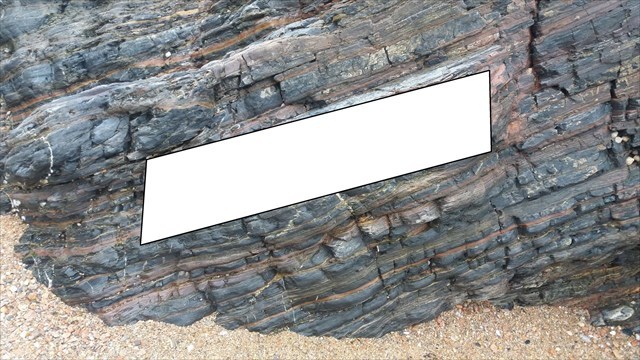EARTHCACHE INACCESSIBLE
A MAREE HAUTE
ET A FORT COEFFICIENT
Le cadre géologique régional :
La côte rocheuse de Brétignolles expose, sur environ 3 km, de la Sauzaie au Marais Girard, des formations d’âge paléozoïque, correspondant aux restes d’une ancienne chaîne de montagnes, le Massif Armoricain, né de l’orogénèse Hercynienne, entre - 390 millions d’années et - 300 millions d’années.
La série métamorphique de Brétignolles au Rocher Sainte Véronique et se prolonge jusqu’au Marais Girard. Elle se rattache à un vaste ensemble de terrains du Bas-bocage vendéen, faiblement métamorphisés, fossilifères, datés de l’Ordovicien, du Silurien et du Carbonifère inférieur .La série métamorphique est en contact tectonique avec l’unité des porphyroïdes de la Sauzaie au niveau du Rocher Sainte Véronique et est intrudée par des massifs de rhyolite au niveau de la Normandelière,
Cette série métamorphique présente un grand intérêt historique et scientifique. Elle a été étudiée pendant près de 50 ans par Mireille Ters (1910 – 1986), brillante universitaire de la Sorbonne et de la faculté d’Amiens. Les brillantes découvertes de cette géologue ont permis, entre autre, de revoir la datation de certains terrains [- 420 Ma (Silurien) au lieu de - 550 Ma (Briovérien) pour les phtanites].
Le phtanite à radiolaires du Rocher Sainte Véronique :
Le rocher Sainte-Véronique, d’une hauteur d’environ 5 m, dressé sur le haut-estran, est constitué d’une roche massive et sombre, extrêmement résistante au marteau du géologue, le phtanite.

Cette roche examinée en lame mince, au microscope optique, apparaît formée essentiellement de quartz en très petits cristaux moulés les uns sur les autres (structure micro-quartzitique).
Elle présente une structure tantôt homogène et tantôt finement litée, le litage étant déterminé par la dimension des grains de quartz (10 à 20 µm) ou par l’abondance de la matière graphiteuse ou charbonneuse responsable de sa coloration grise à noire.
Le phtanite se révèle relativement riche en Radiolaires, ce qui permet de considérer cette roche comme une radiolarite.
Les Radiolaires sont des protozoaires marins et pélagiques possédant un test (squelette externe) siliceux réticulé. Les tests siliceux des Radiolaires sont moins sensibles à la dissolution dans l’eau de mer que les tests des organismes carbonatés et persistent là où ceux-ci ont disparu, notamment dans les sédiments des grandes profondeurs comme celles des plaines abyssales.
Le phtanite peut donc être considérée comme une roche sédimentaire siliceuse et argileuse marine.
Certains affleurements montrent des intercalations de schistes rouges de 1 à 10 cm d’épaisseur, disposées en plis isoclinaux serrés, à charnières aigües, qui replissent la schistosité S1 ; une forte schistosité S2 de plan axial y est développée. Ces figures tectoniques sont bien visibles sur la face sud du Rocher Ste Véronique. D’autres affleurements sont parcourus par des filonnets de quartz d’exsudation.

















 Rappel : Sur une Earthcache, il n'y a pas de boites à trouver
Rappel : Sur une Earthcache, il n'y a pas de boites à trouver

















Pour valider votre visite sur le site,
Loguez cette cache "Found it" et envoyez-moi les propositions de réponses
en precisant le nom de l Earthcache
via mon profil soit via la messagerie geoocaching.com
et je vous contacterai en cas de probleme
LES LOGS ENREGISTRES SANS REPONSES SERONT SUPPRIMES
Q1 : Que sont les RADIOLAIRES ?
Q2 : Avec un morceau de verre, essayez de rayer la pierre, que se passe t il ?
Q3 : Que voyez vous derriere le carré blanc de l image ?



















EARTHCACHE INACCESSIBLE
AT HIGH TIDE
AND HIGH COEFFICIENT
The regional geological framework:
The rocky coast of Brétignolles exposes, about 3 km, from the Sauzaie to the Marais Girard, formations of Paleozoic age, corresponding to the remains of an ancient chain of mountains, the Armorican Massif, born of the Hercynian orogeny, 390 million years and - 300 million years.
The metamorphic series from Brétignolles to the Rocher Sainte Veronique and extends to Marais Girard. It is linked to a vast set of low-metamorphosed, low fossiliferous, low Ordovician, Silurian and Lower Carboniferous Low Vendor lands. The metamorphic series is in tectonic contact with the porphyroid unit of the Sauzaie at level of the Rocher Sainte Véronique and is intruded by masses of rhyolite at the Normandelière level,
This metamorphic series is of great historical and scientific interest. It was studied for nearly 50 years by Mireille Ters (1910-1986), brilliant scholar of the Sorbonne and faculty of Amiens. The brilliant discoveries of this geologist made it possible, among other things, to review the dating of certain lands [- 420 Ma (Silurian) instead of - 550 Ma (Brioverian) for the phthalites].
The phlanite with radiolaires of Rocher Sainte Veronique:
The Sainte-Véronique rock, about 5 m high, stands on the high-foreshore and consists of a massive, dark rock, extremely resistant to the geologist's hammer, phthalite.
This rock, examined in a thin plate under an optical microscope, appears to consist essentially of quartz in very small crystals molded on each other (micro-quartzitic structure).
It has a homogeneous and sometimes finely-lit structure, the bedding being determined by the size of the quartz grains (10 to 20 μm) or by the abundance of the graphite or carbonaceous material responsible for its gray to black coloration.
Phthalite is relatively rich in Radiolaria, which makes it possible to consider this rock as radiolarite.
Radiolaria are marine and pelagic protozoa with a crosslinked siliceous test (skeleton). The siliceous tests of Radiolariae are less sensitive to dissolution in seawater than carbonate organism tests and persist where they have disappeared, especially in sediments of great depths such as those of the abyssal plains.
Phantanite can therefore be considered as a siliceous and clayey marine sedimentary rock.
Some outcrops show intercalations of red shales 1 to 10 cm thick, arranged in tight, isoclinal folds with sharp hinges, which replenish schistosity S1; a strong schistosity S2 of axial plane is developed there. These tectonic figures are clearly visible on the south face of Rocher Ste Véronique. Other outcrops are covered by quartz filaments of exudation.

 : On Earthcache, no boxes to find
: On Earthcache, no boxes to find

Log this cache "Found it"
And send me your proposals for answers either via my profile,
Either via the messaging geocaching.com (Message Center),
And I will contact you in case of problem.

THE LOGS SAVED WITHOUT ANSWERS WILL BE DELETED

Q1: What are RADIOLARS?
Q2: With a piece of glass, try to scratch the stone, what happens there?
Q3: What do you see behind the white square of the image?














